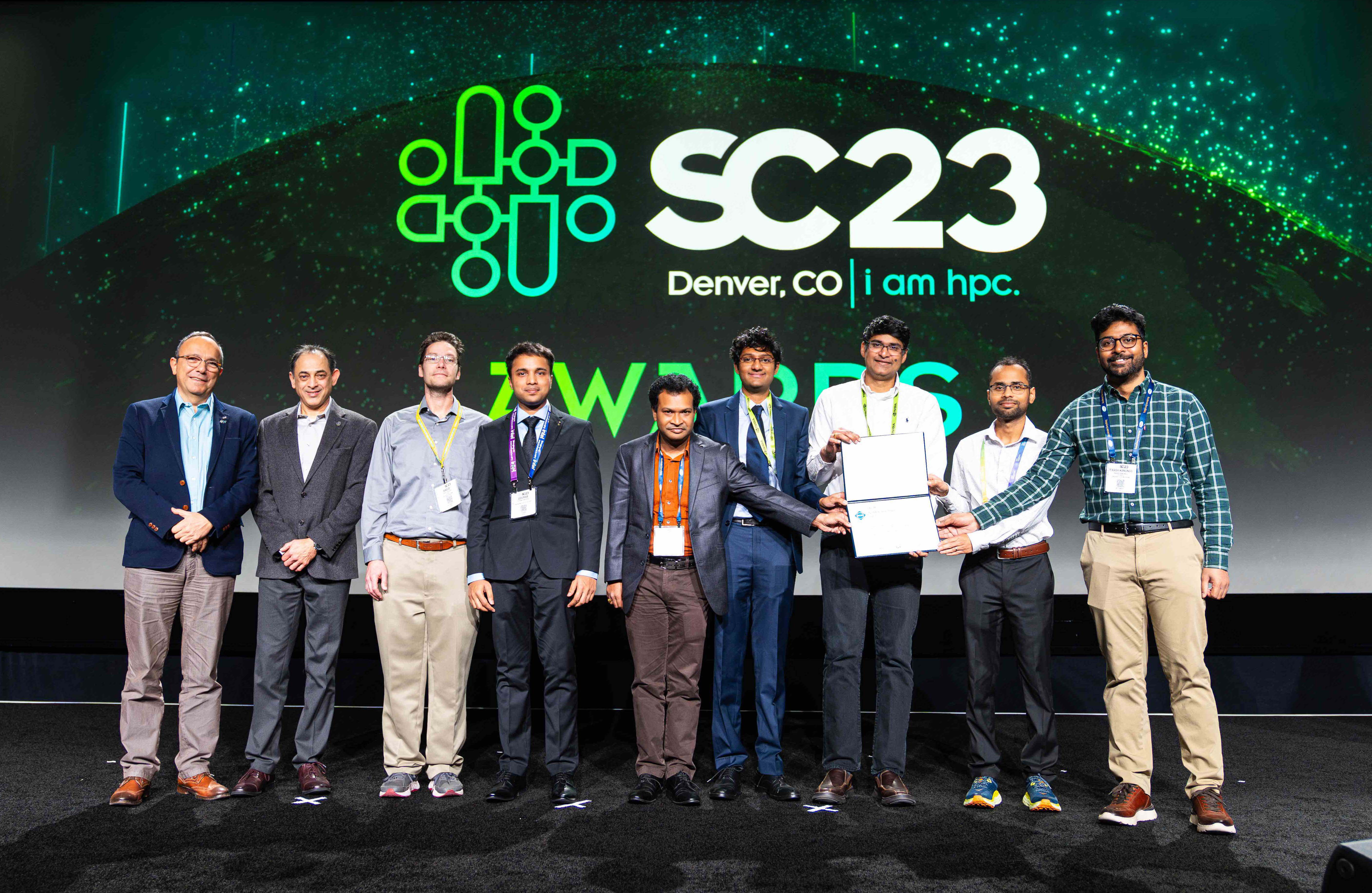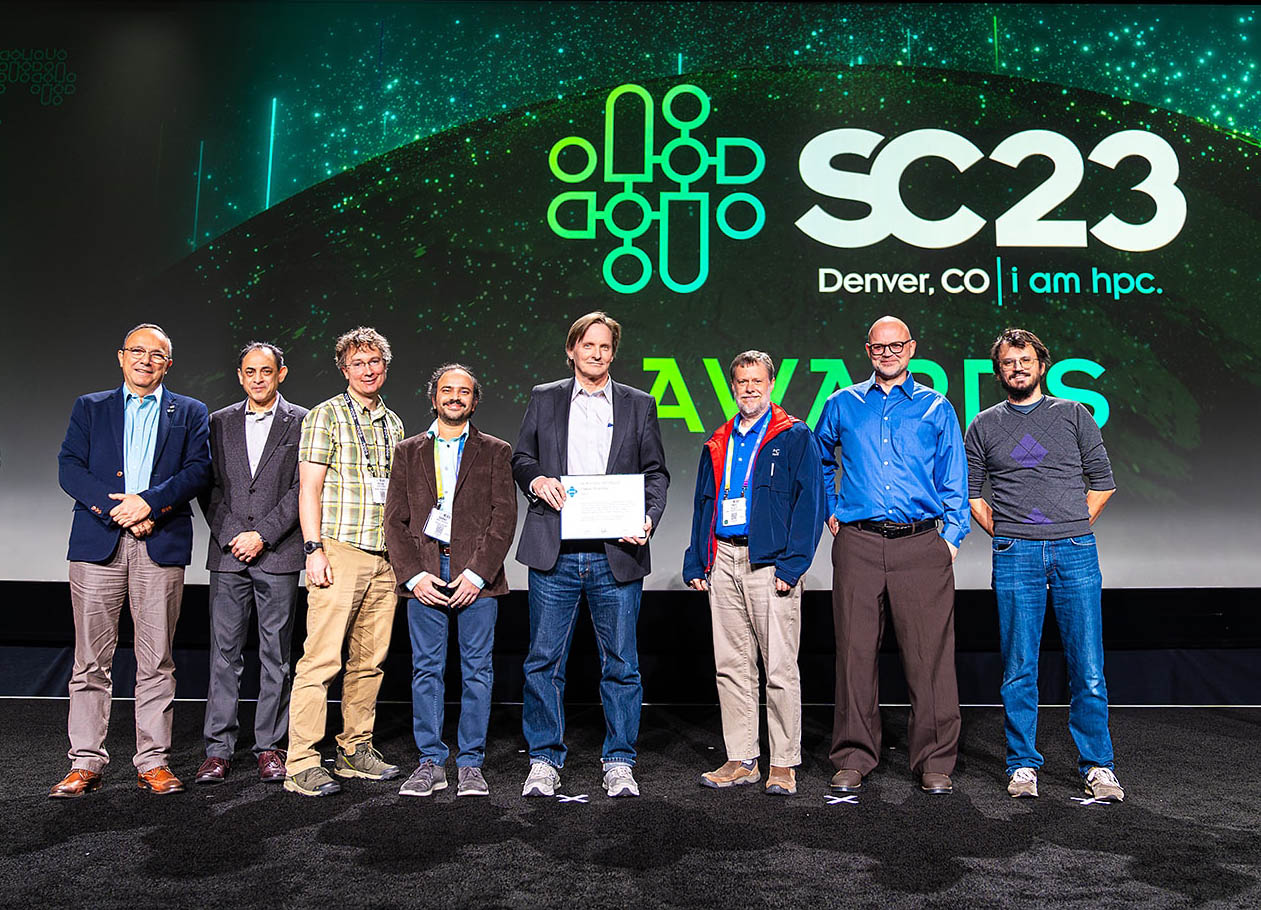Perlmutter System Played Role in Two 2023 Gordon Bell Prize Winning Projects
November 17, 2023
Contact: cscomms@lbl.gov
The two teams that won, respectively, the 2023 Association for Computing Machinery Gordon Bell Prize and the first-ever Gordon Bell Climate Modeling Prize both used the Perlmutter supercomputer at Lawrence Berkeley National Laboratory (Berkeley Lab) as part of their research efforts. The winning projects were announced on Thursday, November 16, during the SC23 conference in Denver.

A collaboration hailing from the University of Michigan, the Indian Institute of Science, and Oak Ridge National Laboratory took home the Gordon Bell Prize for large-scale materials modeling at quantum accuracy. (Credit: Jo Ramsey, SC Photography)
A collaboration hailing from the University of Michigan, the Indian Institute of Science, and Oak Ridge National Laboratory (ORNL) took home the much-coveted Gordon Bell Prize for outstanding achievement in high-performance computing for their project, “Large-scale Materials Modeling at Quantum Accuracy: Ab Initio Simulations of Quasicrystals and Interacting Extended Defects in Metallic Alloys.” Their calculations relied on density functional theory and machine learning to achieve a level of accuracy close to that offered by quantum many-body calculations.
For this work, the team used an integrated computational framework on the Frontier and Summit supercomputers, both housed at ORNL’s Oak Ridge Leadership Computing Facility, to simulate dislocations, or defects, in a magnesium system of nearly 75,000 atoms. Understanding dislocations in magnesium alloys could lead to lighter, more flexible alloys for industry, help design candidates for new alloys, and fuel other computational design efforts such as drug discovery.
Separately, the team used the Perlmutter supercomputer at the National Energy Research Scientific Computing Center to study the stability of quasicrystals – a structure that’s ordered but not periodic – in a ytterbium-cadmium alloy.
“The promise of our study shows this kind of approach should be widely useful across many areas of science and answer some of the challenging questions that have persisted for decades, from aerospace to medicine,” said Vikram Gavini, a professor of mechanical engineering and materials science and engineering at the University of Michigan and co-author on the study. The other team members include Sambit Das, Bikash Kanungo, Vishal Subramanian, and Paul Zimmerman of the University of Michigan; Gourab Panigrahi and Phani Motamarri of the Indian Institute of Science; and David Rogers of ORNL.

A 19-member team comprising researchers from multiple National Labs, including Berkeley Lab, was awarded the Gordon Bell Climate Modeling Prize at SC23. (Credit: Jo Ramsey, SC Photography)
Meanwhile, one of the first research groups nominated for the new Gordon Bell Climate Modeling Prize used Perlmutter as part of its work with the Energy Exascale Earth System Model (E3SM) and won first prize for its project, “The Simple Cloud-Resolving E3SM Atmosphere Model (SCREAM) Running on the Frontier Exascale System.”
The multinational lab research effort, led by Lawrence Livermore National Laboratory, included a record-setting demonstration of SCREAM on the Frontier system at ORNL: 1.26 simulated years per day for a realistic cloud-resolving simulation. SCREAM is a full-featured atmospheric general-circulation model developed for very fine-resolution simulations on exascale machines, incorporating state-of-the-art parameterizations for fluid dynamics, microphysics, moist turbulence, and radiation. The team demonstrated that by using exascale supercomputers along with this new algorithmic model, the longstanding challenge of developing efficient and accurate simulations of deep convective clouds can be accomplished.
“As far as we know, SCREAM is the first such model to run on both AMD GPUs and NVIDIA GPUs, as well as the first to run on nearly an entire exascale system,” the researchers wrote in their submission.
They also acknowledged the role that Perlmutter played in this work.
“We used Perlmutter to debug and improve performance when possible,” said Noel Keen, a software developer in the Earth and Environmental Sciences Area at Berkeley Lab and part of the E3SM and SCREAM teams. “In fact, the first ultra high-resolution simulation that ran with all pieces together was performed on the CPU partition of Perlmutter.”
About NERSC and Berkeley Lab
The National Energy Research Scientific Computing Center (NERSC) is a U.S. Department of Energy Office of Science User Facility that serves as the primary high performance computing center for scientific research sponsored by the Office of Science. Located at Lawrence Berkeley National Laboratory, NERSC serves almost 10,000 scientists at national laboratories and universities researching a wide range of problems in climate, fusion energy, materials science, physics, chemistry, computational biology, and other disciplines. Berkeley Lab is a DOE national laboratory located in Berkeley, California. It conducts unclassified scientific research and is managed by the University of California for the U.S. Department of Energy. »Learn more about computing sciences at Berkeley Lab.







